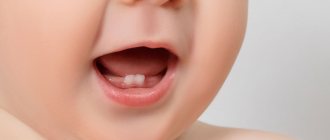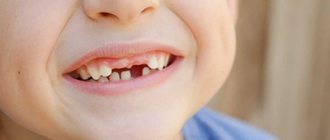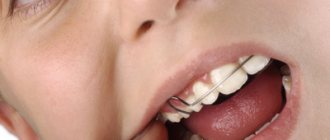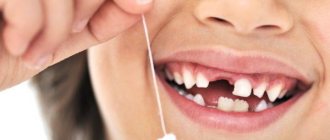Teething is one of the most important periods in a child’s life. This happens at about six months of age, but it is difficult to name the exact timing, since this process occurs individually for each baby. What do parents need to know about the names of their child’s teeth and the pattern of their appearance?
Name of a child's teeth
What are baby teeth?
Milk teeth are the teeth that are the first to erupt in humans. Their rudiments are formed in the womb, at approximately 5-7 weeks of pregnancy, and by the age of three the child already has 20 teeth. Milk teeth differ from permanent teeth in structure (they are smaller and have a different shape), and the bite does not contain small molars, or premolars.
X-ray of baby teeth
Physiological features of the development of baby teeth
The front, or frontal, teeth are located very tightly to each other and only when the child reaches the age of four, diastemas become visible between them - physiological gaps that increase after a year or two against the background of jaw growth. If there are no diastemas at the age of six, this indicates insufficient jaw growth, leads to crowding and requires correction of the bite in children. Physiological abrasion of surfaces, which contributes to the timely development of the masticatory apparatus, begins at three years of age.
Scheme of baby teeth eruption
Normally, baby teeth begin to appear after the child reaches 5-6 months, but this period depends on a number of factors, including the quality and characteristics of the child’s diet, the region of residence and even the weather. Some children are born with one or more teeth; most often they must be removed because they interfere with normal sucking.
On a note! Milk teeth erupt symmetrically according to the so-called antagonizing principle, that is, teeth of the same name appear approximately simultaneously, and the process begins from the lower jaw. The exception is the lateral incisors, which begin to erupt from above.
Numbering of baby teeth
First, the two lower central incisors are shown, then the two upper ones, which are located directly above them. This order of teething ensures contact between the teeth and gives the baby the opportunity to begin to practice chewing solid foods. By the age of one year, a child, as a rule, has eight teeth. Next, two fangs grow - first on the lower jaw, then on the upper, after which the teeth of the chewing group (molars) erupt. At three years old, children can already fully bite and chew solid food.
Approximate order and pattern of appearance of baby teeth
| Name | Age, months |
| Central incisors on the lower jaw | 6-7 |
| Central incisors on the upper jaw | 8-9 |
| Lateral incisors, upper jaw | 9-11 |
| Lateral incisors, lower jaw | 11-13 |
| Upper molars (first) | 12-15 |
| Lower molars (first) | 12-15 |
| Fangs | 18-20 |
| Second molars | 20-30 |
What are teeth called in dentistry: designation systems
- Two-digit numbering. Designation in accordance with international standards. In addition to the tooth number, the quadrant of the oral cavity is indicated. Quadrant numbering starts from the top right side with 1, then to the top left side (2), bottom left (3) and bottom right (4). If the number 21 is written, then we are talking about the central left incisor of the upper jaw.
- Square-digital. In this case, the jaw is divided into two equal areas. The elements of the dental system are counted from 1 to 8. For the most accurate identification of a dental unit, the number, jaw and location are prescribed.
- Universal. An accessible designation in which each unit of the dentition is assigned a number from 1 to 32. The Latin alphabet is used to identify primary teeth.
In addition, the alphanumeric and Haderup systems are used, but they are used extremely rarely in practice.
How does the process work?
When the time comes for teething, the baby usually becomes restless, begins to put toys and other things in his mouth, bites his chest with his gums, and begins to salivate profusely. Parents may notice a small bump on the gum filled with fluid; the mucous membrane in this place becomes red and swollen. After some time, white spots clearly appear through the soft tissues - this means that the tooth is ready to be born.
Milk and permanent teeth
Important! If the lump becomes too large and causes serious discomfort to your baby, you can ask the doctor to cut it to “help” the tooth get out.
The body's reaction to teething depends on its individual characteristics. In some children this process is asymptomatic, in others the temperature rises, a runny nose, redness of the throat, diarrhea, sleep and appetite worsen.
Attention! If teething is difficult, accompanied by fever and other symptoms, it is better for parents to consult a doctor. Typically, in such cases, antipyretic and analgesic drugs are prescribed, as well as ointments and gels that reduce discomfort in the gums.
Types of teeth
You can relieve discomfort from teething by massaging your gums (performed with a clean finger) or by purchasing a special stimulator ring at the pharmacy.
- When do children's fangs change to permanent ones?
What to do if baby teeth are delayed?
The absence of signs of teething in a child at a time when other children already have several teeth is not a cause for concern. The exact timing depends on several factors, including:
- genetic characteristics;
- climate and living conditions;
- feeding habits (in children who are breastfed, teeth usually appear later than in “artificial” children);
- quality of child care;
- nutrition and living conditions of the mother during pregnancy;
- the presence of chronic diseases and pathologies.
Numbering of teeth in dentistry for children
A situation where teeth are completely missing in a one-year-old child should be a cause for concern - sometimes this is a variant of the norm, and sometimes it indicates disorders in the body.
Important! The most common pathologies that can affect the timing of teething are dysfunction of the endocrine system and rickets.
Less common is a disease called edentia, or the absence of tooth buds, which can be diagnosed using x-rays.
What to do when teeth grow in two rows
With “shark” jaws, the most reasonable solution seems to be the removal of excess milk units. And they did this for a long time. The result of hasty decisions showed that hasty removal of primary incisors and fangs leads to the opposite result and the formation of a malocclusion. After this, pediatric dental surgeons began to see children only as prescribed by the orthodontist - after professional consultation with a specialist.
An orthodontist is the first doctor you should go to when teeth grow in two rows. The doctor will assess the prospects for the formation of the dentition, send you for an x-ray to accurately determine the rudiments of permanent teeth and make the right decision. And this will not always be immediate removal of a baby tooth!
Based on the results of the diagnosis and examination, the orthodontist can advise:
- increase the amount of solid food in the child’s menu - provide the missing pressure on the baby tooth, causing it to loosen and fall out;
- wait for the natural change of teeth so that the permanent unit moves into its intended place under the influence of other teeth and under the pressure of the tongue muscles;
- remove primary incisors and canines to forcefully free up space.
The latter purpose is typical for parallel growing teeth and firmly standing primary units, since this is the only case when there are no natural prerequisites for root resorption and normal bite changes.
Caring for baby teeth
Children should be taught oral care procedures from early childhood. After the first teeth appear, it is recommended to gently wipe them once a day with a clean piece of gauze soaked in boiled water. As your baby gets older, you can purchase your own soft-bristled brush and brush your teeth with water. After the baby reaches one year of age, it is recommended to purchase a special paste and teach him how to care for the oral cavity on his own.
Teeth of the upper and lower jaw
Milk teeth, like permanent teeth, are susceptible to decay and caries, which can appear even in children under two years of age.
On a note! The main feature of childhood caries is multiplicity, that is, it often affects not one, but several teeth, penetrating into the deep layers of tissue.
At the spot stage, the disease is treated with fluoridation; in case of an extensive pathological process, cleaning of carious cavities and removal of infected tissues is necessary.
Formula for recording baby teeth using the Haderup system
The structure and significance of teeth
Teeth in mammals are divided according to their shape and purpose into incisors
,
canines
and
molars
.
Human teeth are similar to the teeth of mammals. They are also located in special
holes called
alveoli
, and
are divided
into
incisors, canines
and
molars
.
An adult usually has 32 teeth: 4 incisors, 2 canines, 4 molars
and
6 large molars on each jaw
. Teeth have a characteristic shape and structure and occupy a certain position in the dentition.
Incisors
located in the front parts of the jaws, have an upper cutting edge and are intended mainly for grasping and cutting food.
The canines
follow the incisors, they are pointed and usually serve to hold and tear food.
Behind the canines are the molars
. They have an extensive chewing surface and are used to crush and chew food.
Teeth are necessary for holding and grinding food, take part in the formation of speech sounds and are an important part of the mouth.
Structure of teeth
A tooth consists of
a crown
(
the part of the tooth that protrudes above the gum
),
a neck
and
a root
(
the part of the tooth located deep in the alveolus and covered by the gum
).
The basis of the tooth is hard tissue
-
dentin
.
On the crown it is covered
with enamel , and on
the neck and root
-
with cement
.
Dentin
and
cement
are types of bone tissue. The neck of the tooth is covered with the thinnest layer of enamel.
Enamel
- the hardest tissue in the human body. This is explained by the high content of inorganic substances in it - up to 97%. However, even this can wear out and crack. Healthy enamel also contains 2 - 3% water and 1 - 2% organic substances (proteins, lipids and carbohydrates).
There is a cavity inside the tooth - a root canal
filled with dental pulp, or
pulp
.
It is represented by loose connective tissue containing blood vessels and nerves
.
Newborn babies have no teeth. At the age of 3 months, children begin to erupt baby teeth.
.
From about 6 years of age, children begin to develop permanent teeth
.
Their rudiments appear at the roots of baby teeth. The permanent teeth begin to grow and squeeze the roots of the milk teeth, blocking the path of blood. Deprived of nutrition, the roots of baby teeth dissolve. Baby teeth gradually fall out and are replaced by permanent teeth. This process ends by 10–12 years. The exception is the last pair of large molars, the so-called “ wisdom teeth.”
Their appearance is delayed in some people until 20–30 years, and in some they may not appear at all.
The closure of the upper teeth with the lower ones is called
a bite
.
With a correct bite, the upper canines block the lower ones, and the upper incisors are located in front of the lower ones
. This enhances their cutting action.
Healthy teeth are one of the important conditions for the normal functioning of the digestive system. A damaged tooth can cause a variety of diseases. Infection and inflammation can spread throughout the body.
The digestion process is disrupted, as food that is insufficiently chewed and not prepared for further chemical processing enters the stomach.
Causes of dental disease. If you do not properly care for your teeth, food particles remain between them, which undergo fermentation, resulting in the formation of lactic acid. It acts on tooth enamel and causes the dissolution of minerals.
A yellowish coating of microorganisms that live in the oral cavity appears on the affected area of enamel. They continue to destroy the minerals of the tooth. As a result, a carious cavity
. Microorganisms penetrate into it and cause caries - the gradual destruction of the tooth. If you do not put a filling on the damaged area, the tooth will gradually collapse. In such cases, you need to consult a dentist.
Caries
- the most common human disease. It occurs in 93–95% of people. In childhood, it ranks first among chronic diseases and occurs 5–8 times more often than the second most common disease - bronchial asthma. According to various authors, about 80% of adolescents have carious cavities at the time of graduation.
Eating food that is too hot or cold, biting nuts, chewing hard candy, and drinking hot food with cold drinks lead to enamel cracks.
. They easily become trapped by food particles on which bacteria multiply. Gradually, the cracks increase and carious lesions occur.
The tobacco tar contained in tobacco causes great harm to teeth and gums. It settles on the teeth and forms a yellow plaque, which after some time turns into tartar.
To avoid dental damage, it is important to maintain oral hygiene
.
It is necessary to brush your teeth with a brush and toothpaste 2 times a day after meals (morning and evening). The main procedure is to brush your teeth in the evening before going to bed, since unremoved plaque and food formed during the day contribute to the rapid proliferation of bacteria and, consequently, the development of caries. Remaining food particles between the teeth are removed using dental floss
. Metal objects, such as needles, should not be used, as they can damage the enamel.
You should visit a dentist several times a year.
Lesson summary. Teeth are involved in the mechanical processing of food. Between 6 and 12 years of age, baby teeth are replaced by permanent teeth. A person usually has 32 teeth, which include incisors, canines and molars. Teeth need daily care. They should be brushed twice a day after meals. Caries is the most common dental disease. Sick teeth need to be filled.
When do permanent teeth appear?
The replacement of baby teeth with permanent teeth occurs once in a lifetime, in early preschool age. Permanent teeth are divided into two groups: replacement teeth, that is, those that have “twins” in the primary dentition, and additional teeth (premolars and molars). The timing of the eruption of permanent teeth is also individual and depends on genetic factors, region and living conditions, and quality of nutrition.
Structure of a baby tooth
| Name | Age, years |
| Molars (sixths) upper and lower | 6-7 |
| Central incisors on the lower jaw | 6-7 |
| Central incisors on the upper jaw | 7-8 |
| Incisors on the side of the lower jaw | 7-8 |
| Incisors on the side of the upper jaw | 8-9 |
| Fangs on the lower jaw | 9-10 |
| Fangs on the upper jaw | 11-12 |
| Premolars (4s) | 10-12 |
| Second premolars (5ths) | 11-12 |
| Second molars (7s) | 11-13 |
| Third molars (wisdom teeth) | 17-25 |
Dental formula
For reference! The eruption of permanent teeth usually does not cause children any discomfort - after the roots are reabsorbed, the baby teeth fall out on their own, and permanent teeth appear in their place.
During this period, parents need to monitor the child’s proper oral hygiene, as well as ensure that the permanent teeth grow evenly, without gaps or distortions. If the bite has defects, it is necessary to consult an orthodontist as soon as possible to correct it. Find out about the alveoli in the mouth from the article.
- Molars in children: order of eruption
Video - Baby's first teeth
Odontogenesis: the process of tooth formation
The crowns of the front milk teeth are formed in the prenatal period; they lie in the dental sacs inside the jaw. When a child is born, the formation processes continue, the roots of the teeth grow, and the interalveolar septa separate in the gums.
The tooth takes up more and more space, because of this, as well as under the influence of anatomical and physiological changes, part of the gum atrophies, and the crown of the tooth comes to the surface. When this happens depends on:
- the child's health status;
- nutrition;
- heredity.
In general, the eruption of primary teeth begins at 6-8 months with the lower central incisors, and the lateral incisors soon appear. After a few months, the first molars become visible, then the canines and second molars. On average, the eruption process ends in 20-24 months. The appearance of teeth at an earlier date is less common, and a delay in onset of up to 10-12 months is much more common [1].
If there are obvious violations of the order or very delayed teething, the child must be examined to exclude diseases or pathologies of the structure of the teeth. It is important to understand that the development of baby teeth affects the oral cavity and facial skeleton, posture and even the psycho-emotional indicators of the child. From the age of 6-7 years, baby teeth gradually fall out and are replaced by permanent teeth [1]










